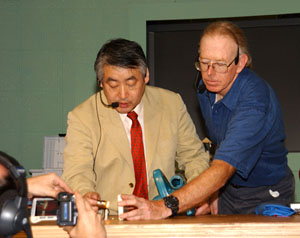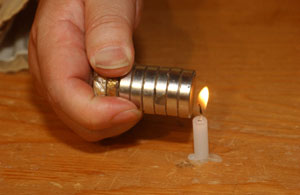
Dr. Takikawa brings a large neodymium magnet near a candle flame. Paul Doherty blocks local breezes.
Try This! Bend a Flame with a Magnet
An exploration demonstrated by Dr. Yoji Takikawa

Introduction
Push a candle flame with a strong neodymium magnetic.
Material
A birthday candle and matches
A neodymium magnet at least 2 cm in diameter and 3 cm long (1 inch
diameter and 1.5 inches long)
available from Educational Innovations (web link)
Important note, this experiment will only work with a strong neodymium magnet, do not try to substitute any other type of magnet. Neodymium magnets are more than an order of magnitude (10X) stronger than other types of magnets.
A large metal bolt with a head about the size of the face of the magnet.
Try This
Light the candle.
Bring a pole of the magnet near the flame. Notice that the flame is deflected away from the magnet.

Bring a piece of metal about the size of the neodymium magnet near the flame, notice that the flame is attracted to the metal.
What's Going On?
Oxygen in the air is attracted to a magnet.
Inside a candle flame the oxygen has been removed by the very chemical reaction that made the flame glow.
So the magnet pulls oxygen in the air next to its poles, this forces the oxygen free candle flame away from the poles.
The candle flame is attracted to the bolt since the candle flame accelerates upward. When a gas increases its speed as it flows upward next to a surface a low pressure is generated next to the surface. Atmospheric pressure then pushes the flame toward the lower pressure near the surface.
So What?
Dr. Takikawa hopes that the use of strong magnets made by electromagnetism will allow forces to be exerted on the flame equal to the forces of gravity. This will allow zero gravity experiments on burning flames here at the surface of the earth.
Going Further
Place a piece of aluminum foil between the candle flame and the magnet. move the magnet toward and away from the flame. Have someone else do this randomly using the magnet or the bolt. See if you can tell whether they are using a magnet or not. This is called a "blind" experiment and is a technique scientists use to try to make sure that they are not imagining small results.
Try the opposite pole face of the magnet, does it also deflect the flame?
Make a soap bubble full of carbon dioxide gas. is it attracted to or repelled from a neodymium magnet?
Paul Doherty
|
Scientific Explorations with Paul Doherty |
|
19 July 2003 |